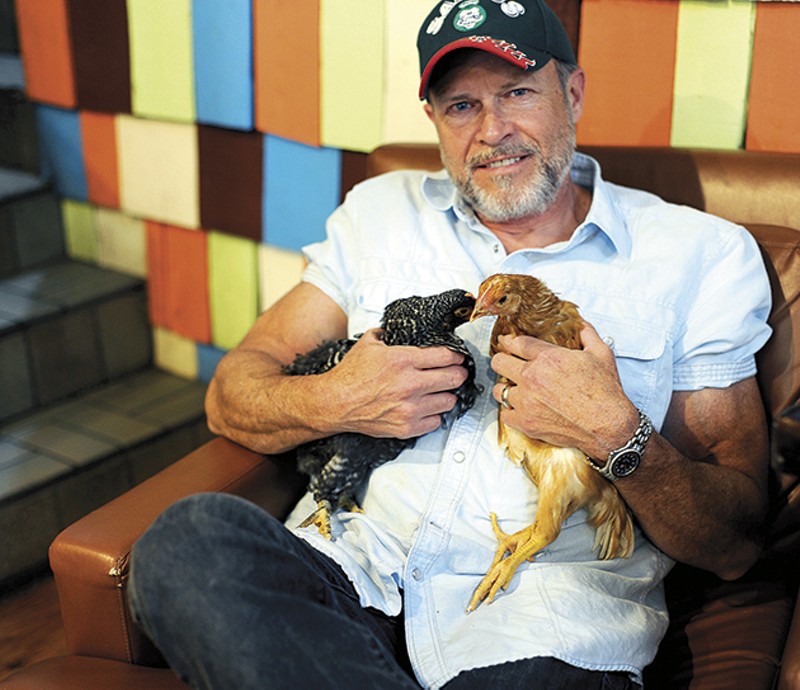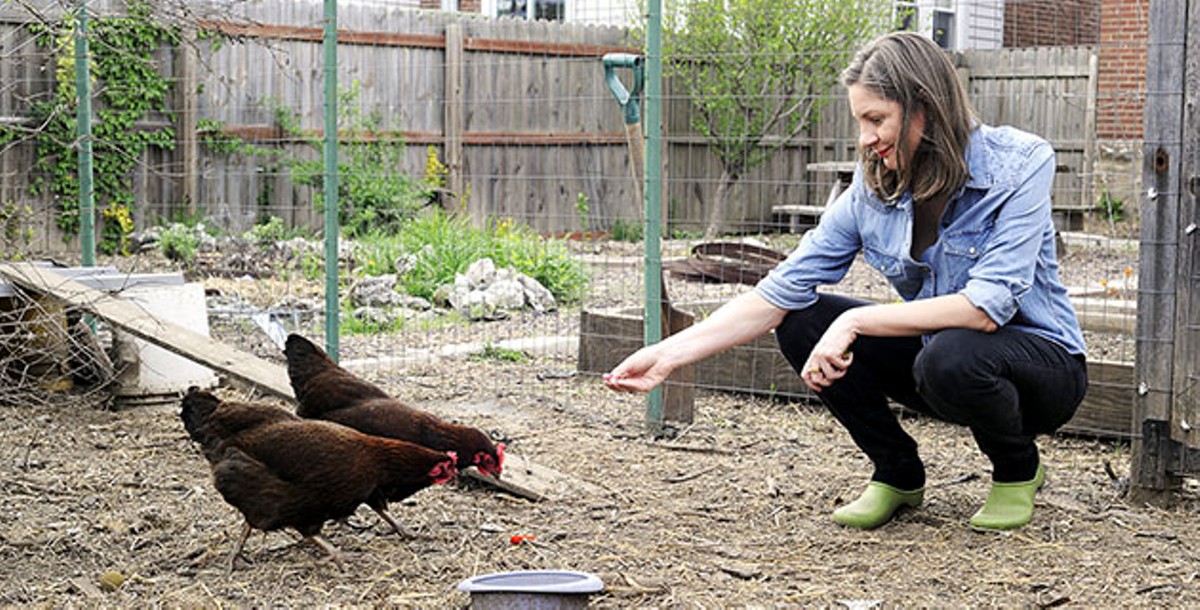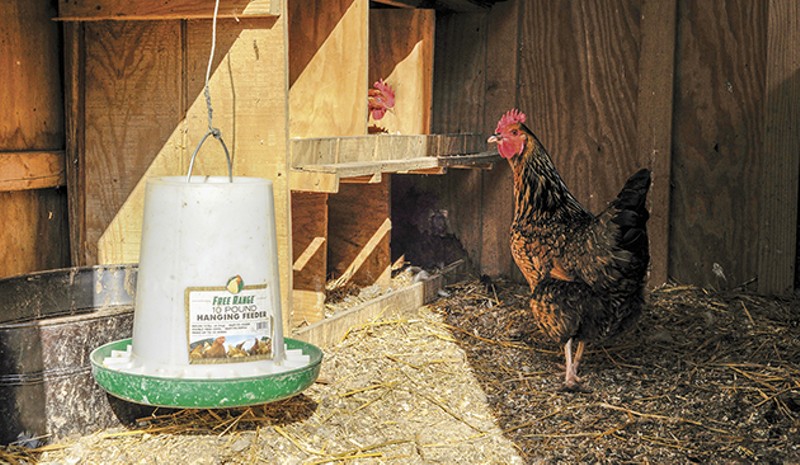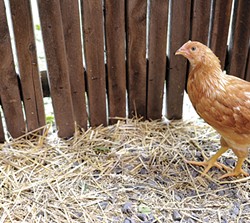People in all kinds of environments now raise chickens, many of them in urban contexts. In the past decade, the trend has changed from a quirky thing to a more regular occurrence; just walk, ride or drive through alleys in my own Tower Grove East neighborhood, and you'll find a coop every few blocks. There's a nice one just a few doors down from me. On the neighborhood's Facebook discussion group, folks regularly post about either a) looking for a loose bird, or b) seeing a loose bird. Usually, through these conversations, there's a happy ending.
Of course, this isn't a neighborhood-specific thing; folks raise in all kinds of contexts throughout St. Louis, in urban and suburban environments, raising them in set-ups that range from the scrapwood, homemade units to $1,000 pre-fab kits.
Even by an unofficial count, I've got at least a dozen friends, neighbors and co-workers rocking the backyard bird lifestyle, with as many different coop solutions. One, Jen Bradford, has just built a coop for "zero dollars, and you can quote the hell out of me on that."
Bradford, who lives in Tower Grove South, explains that she's still looking for "the perfect piece of corrugated sheet metal for roofing," but she's not worried: "The universe will provide."
She explains, "The sides and roof were made from an old section of fence that was sawn in three parts. Most of the rest came from what I assume was an old built-in, the parts of which I found in an alley in Fox Park. Other assorted boards came from various bountiful south side alleys, as did the leftovers from a roll of tar paper that's currently covering the roof. The screws were left over from another project."
The reason for such efforts is multi-fold. My own initial adoption of four pullets came from a generalized sense that I should do better. As in: generally doing better. Eating better. Digging in the dirt. Raising some food, instead of grass. Connecting to nature. (One of the narrative arcs that tends to accompany conversations about chicken-keeping revolves around wartime America, when people of all backgrounds, ethnicities and social classes would keep "Victory Gardens," with chickens, ducks and geese a regular part of the equation. Admittedly, we're not in that particular kind of wartime stress today, but there's always wisdom that emerges from the worst of days.)
Opponents of marijuana accuse the drug of "gateway" qualities; take a puff, they fear, and pretty soon you'll be booking time at the rehab clinic. Chickens might have a similar quality. First, you build a decent-sized production garden. Then you add some birds. A switch is flipped. Pretty soon, you start spending time in the garden section of bookstores, you start quoting Novella Carpenter, you see scrap wood in an alley and start wondering about how easy it'd be to build a rabbit hutch. Heck, the chicken yard's big enough for a goat, if you really think about it...
Typically, folks get into the chicken game for the eggs as opposed to the meat. When you go to Craigslist, you'll see that distinction made pretty quickly; "meat birds" are just that, raised for dietary purposes, selling for roughly $10 a bird, from a blend of meat-production breeds. Layers, meanwhile, cost roughly the same, though more exotic birds (like our Icies, at $25 a pop) go for a bit more. While a few folks go the egg-to-grave route and buy fertilized eggs or chicks, you can go to a store like Fenton Feed Mill and load up a whole flock of juvenile pullets for less than $20.
The cost-per-egg, of course, is another conversation. And it's one that we'll have momentarily. But there's something unquantifiable that comes with the very first day of chicken-keeping. It's hard to put a price on entertainment.
Chickens are peculiar to watch. They fight and tussle. They confidently walk out of a gate; ten seconds later, they can't find their way back in. They perch in strange places and bathe in dirt. They do weird things, all day long. You can spend glorious chunks of time watching them.
Holly Schroeder, a south city resident, recently discontinued her small flock, referring to that experience on Facebook as "the end of Chicken TV." Asked about it later, she explains, "Chicken TV is when you sit outside and watch the hens peck about the yard."
The appeals? "It's meditative," she writes. "It's totally being in the moment. Mindfulness meditation."

Just off the intersection of Compton and Shenandoah, not far from my house in Tower Grove East, is a quaint coffeeshop and cafe, Kitchen House Coffee. The space has seemingly reversed a trend of cafes coming and going in that location. It's still going strong in its third year in operation.
The appeal lies not just with an excellent array of coffee, friendly service and tasty, light lunches, but with the four birds who live on site. Located in what could rightly be called a downright "cute" coop and chicken yard, the Kitchen House birds are both workers (producing eggs for the shop) and curiosities. Often, they sit on the step leading down into their yard, all four of them peering into the shop's window even as customers stare back out at them.
Paul Whitsitt, the cafe's proprietor, says, "The chickens are an attraction for our customers — many parents bring their young children to the shop to see them, and even adult customers often go out back to see the hens up close or feed them. These girls have gotten used to the attention and don't seem to mind visitors. In fact, as you've noticed, they seem to find the action inside the coffee shop quite interesting and spend much of their day looking at customers through the back door."
Whitsitt has personally gotten the bug, to the point that he keeps not one, but two flocks thriving and, yes, producing food.
"We have chickens at the coffee shop for a few reasons," he says. "I started our small urban farm on the double lot behind our Tower Grove East home in 2012-13. When I decided to open Kitchen House Coffee in 2014, I knew I wanted the shop to have an urban farm theme and to connect the farm and the shop. Having chickens in our small backyard space at the coffee shop is an obvious visual that helps accomplish that goal." Plus, he says, "Depending on the time of year, how many girls are consistently laying, and the volume of customer demand for our egg dishes, the farm and coffee shop hens' eggs can be a significant contribution to these menu items."
Yes, raising chickens comes with that whole back-to-the-land element, but if you're not born with hippie genes, you might not hear that call. And chickens can be an expensive hobby. Even if you build your own coop and feed your birds nothing but scraps from the neighborhood bakery, hidden little costs always emerge.
Ultimately, though, there's a pull from this word: taste. Or: flavor. Whether you're a master baker or someone who simply likes a good hard-boiled egg, the taste can be the ultimate reason for embracing backyard poultry.
Asked about the plain, simple goodness of home-hatched eggs, Whitsitt notes, "Customers often tell me how flavorful they find our egg dishes, and I believe that is at least in part because of the fresh, free-range nature of these eggs. As a child growing up with a set of farmer grandparents, our eggs were almost always free-range local when such things weren't available in the typical chain grocery store. We took the bright orange yolks and strong flavor for granted."
He continues, "On those rare occasions when my mom had to buy eggs at the store, my sisters and I were surprised by the pale yellow yolk and disappointed by the bland taste. I have to admit, however, with all the egg options now routinely available in our grocery stores (organic, cage-free, free-range, etc.), these days I find the differences in store bought and backyard-raised eggs less dramatic. Of course, I always imagine that the eggs I helped raise taste the best, but I'm not sure I'd pass a blindfold test!"
Only a few minutes' drive from Kitchen House is another cafe called Milque Toast. There, our journey into flavor got serious.








